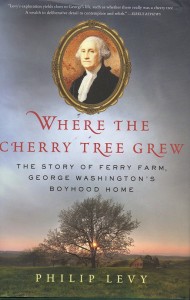Book Review: Where the Cherry Tree Grew by Phillip Levy
Full Disclosure: I received this book as a Goodreads giveaway, on the premise that I would review it.
This is something a little different for me, a geographical “biography” that traces the history of a particular place. In this case, the piece of land that became known as Ferry Farm, where George Washington lived during his boyhood years. The title alludes to the infamous Parson Weems story in which young George takes a hatchet to his father’s favorite cherry tree and owns up to it.
The history begins with the first written accounts of the area, back when the Rappahannock was a wild river, where the West began. It mentions the first person to put a house on this particular tract, Maurice Clark, and a bit about his structure (traces of which were found by the author’s archaeological team.)
There’s a fair bit on the Washington years, some from actual records and other pieces extrapolated from what was dug up there. At the time, the Washingtons were an unremarkable family, planters and slaveowners like most of the local gentry. Some difficulty over the land (which George inherited, but not without strings) meant that young George Washington had to make his own way in the world, with the results most readers will be familiar with.
One notable thing here is that the original Washington house vanished bit by bit over the years–when Washington surveyed the land shortly before selling it off, he didn’t mention its location at all. And at the time, the people of Fredericksburg weren’t much interested in memorializing Washington, even after he became president of the United States.
Interest in the farm perked up, however, after it was visited by Parson Weems, who claimed that he had interviewed many of the older locals and learned of George Washington’s childhood. It is evident now that many of his stories were made up, though at one time there had been cherry trees on the property.
After Weems came a string of promoters and farmers who tried to make something out of Ferry Farm’s connection to the first president, interrupted by the Civil War and the near destruction of Fredericksburg and everything in the vicinity. Even the Washington Bicentennial (1932) failed to get Ferry Farm off the ground as a viable historic site. Only the threat of Wal-Mart paving the whole place over as a parking lot finally got enough money and interest flowing.
Chapter Nine is an abrupt shift from third person to first person, as it details the author’s archaeological dig and how they finally found the foundations of the Washington house. i found the shift offputting, and it might have been better left in third person.
The book wraps up with a meditation on what Ferry Farm meant to Washington, and what the cherry tree story, however fabulous, has to teach us today. There are black and white photographs in the center of the book, copious footnotes, and a complete index.
I’d recommend this book to the Washington completist, American history buffs, and the geography student looking for something different to read.

